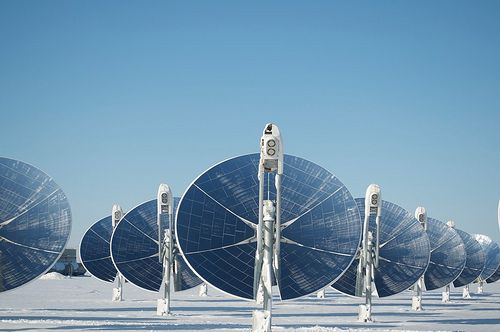 Infinia’s PowerDishPhoto: PowerPlay SolarThe Obama administration last week gave a $62 million boost to efforts to make solar power truly competitive with coal.
Infinia’s PowerDishPhoto: PowerPlay SolarThe Obama administration last week gave a $62 million boost to efforts to make solar power truly competitive with coal.
“The projects announced today will seek to improve component and system designs to extend operation [of concentrated solar power projects] to an average of about 18 hours per day, a level of production that would make it possible for these plants to displace traditional coal-burning power plants,” the Department of Energy said in a statement announcing cash grants that are being doled out over the next five years.
The recipients are companies developing technology to store energy generated by solar thermal plants so that it can be used at night or when the sun doesn’t shine. In the utility biz, that’s called baseload power. (Solar thermal plants typically use vast arrays of mirrors to focus the sun on a liquid-filled boiler to create steam that drives an electricity-generating turbine.)
It’s hardly a huge amount of cash. But it’s going to a mix of startups and big old-line tech companies — many in California — that are working on some potentially game-changing technology.
But how much of the game needs to be changed? That question seems heretical — we’ll have achieved renewable-energy nirvana when solar farms grow electrons 24/7, right? But it was raised by J.D. Sitton, chief executive of Infinia, a solar startup backed by prominent green-tech venture capitalist Khosla Ventures as well as eSolar founder Bill Gross’ Idealab and Vulcan Capital, the Seattle investment firm run by Microsoft cofounder Paul Allen.
“There’s a raging debate in the solar thermal business about how much is storage worth and how much it matters,” says Sitton, whose, Kennewick, Wash., company, scored $3 million from the Department of Energy to create storage technology for its Stirling solar dish.
Resembling a large mirrored satellite receiver, Infinia’s 21-foot-tall PowerDish focuses the sun on a Stirling engine suspended on an arm over the center of the device. The heat causes a gas inside the engine to expand and drive a piston that generates electricity.
The DOE grant — and others Infinia has received from the federal government — will allow the company to integrate storage capacity into the dish apparatus. Sitton says that will involve some form of molten salt that will store PowerDish-generated heat that can be released to drive the Stirling engine when the sun is not shining.
Adding storage to a solar power plant also increases its cost — the more hours you want to run a solar farm, the more storage you need — and Sitton says the key is balancing that capacity with the demand on the grid.
“We can do a 15-minute system, a one-hour system, and, with the latest award, we can do baseload — 12 hours,” says Sitton. “I don’t think the market particularly needs that — taking a peak solar resource and trying to deliver it at midnight.”
Rather than allowing a solar power plant to operate around the clock, the real benefit of energy storage, he says, will be to transform solar power plants into a consistent and reliable source of electricity for grid operators.
In other words, when clouds or other weather conditions cause electricity production to dip, storage systems can release heat to keep the power flowing smoothly to the grid. That enhances the overall reliability of the renewable energy grid and in turn increases the value of solar farms to grid operators.
And just 15 minutes of stored production could make a world of difference, according to Sitton.
“Fifteen minutes is a real differentiator as grid operators can count on the solar resource to be there,” he says. “If you go talk to the grid operators in Spain, they’ll tell you they’ve got some headaches due to high penetration of wind — the episodic nature of the wind resource drives them a bit batty.”
Storage also could give solar thermal technology an edge over increasingly popular photovoltaic farms, which use semiconducting materials like silicon to convert sunlight directly into electricity but do not generate heat. The only current way to store electricity generated from PV power plants is batteries — an astronomically expensive proposition.
As solar cell prices have plummeted over the past year and some solar thermal power plant projects planned for the Mojave Desert remain bogged down in environmental disputes, California utilities have been signing ever-larger deals for photovoltaic power.
Energy storage for solar thermal plants would help balance the solar grid.
So, does that mean there’s no place for solar power plants that can operate 12 or 18 hours a day? Not at all. As the grid becomes more decentralized with the addition of electric cars, rooftop solar arrays, small-scale wind turbines, and other sources of renewable energy, being able to balance supply and demand will become more important than ever.
And in some hot regions of the country where demand peaks later in the day as everyone turns on their air conditioners upon returning home from work, such solar farms could replace so-called peaking fossil-fuel power plants that sit idle for most of the year at great expense. (Andrew Tang, a PG&E executive, recently told me that some of his utility’s peaking plants operate only 50 hours a year.)
But there should be no illusion that even round-the-clock solar farms alone will send coal-fired plants to the fossil-fuel bin of history. In the United States, solar thermal power plants are mainly limited to the desert Southwest, a region that receives strong direct sunlight. They are not feasible in the coal-dependent Midwest and East. Still, the Southwest currently relies heavily on coal and will need to find alternatives if significant climate change legislation is ever enacted. (Even California, which does not operate coal-fired plants, imports out-of-state dirty power to meet 20 percent of its electricity demand. Under current law, it will have to replace those imports with green energy.)
And there’s no shortage of interest by companies seeking to devise energy storage solutions. eSolar, for instance, scored $10.8 million to pursue a new power plant design.
Bill Gross of eSolar told me the startup wasn’t yet ready to talk in detail about that project, but DOE described the technology this way: “Instead of one central tower and receiver, the plant will employ multiple, modular towers. Using reflective mirrors, the sun’s radiation will heat a liquid salt within each receiver. A specialized molten salt transport system will then move the high-temperature fluid to a molten-salt steam generator that produces electricity.”
Abengoa Solar, the U.S. arm of the Spanish renewable energy company, will also pursue molten salt technology with its $10.6 million grant. Rocketdyne, the United Technologies subsidiary that pioneered molten salt technology and which licenses it to Santa Monica startup SolarReserve, received $10.2 million to develop a next-gen version.
The DOE also is funding feasibility studies of more cutting-edge technologies, such as storing energy in solid modular blocks.
And a company called Terrafore, based in Riverside, Calif., will develop a storage system that “takes advantage of the energy that is transferred when materials melt and solidify.”
Talk about a hot technology.



